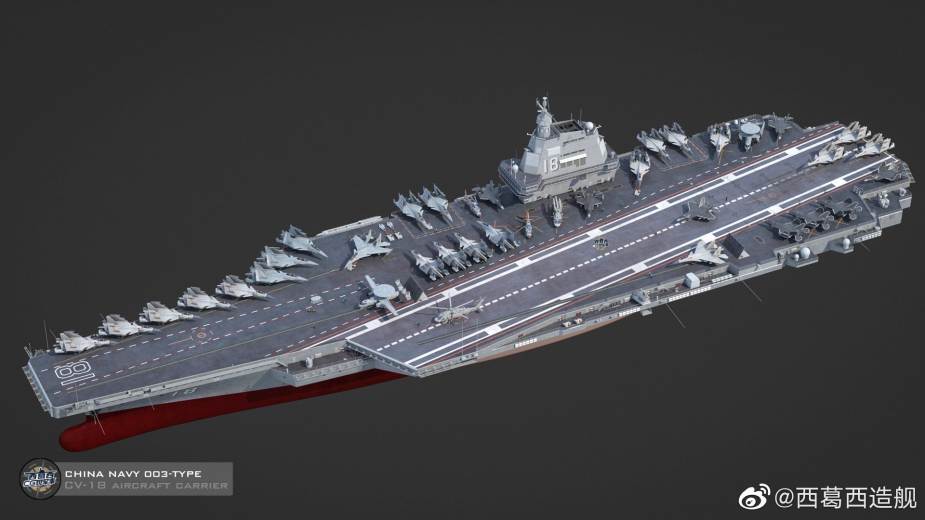“Critical Design” Flaws In China’s Fujian Aircraft Carrier; Less Capable Than Decades-Old U.S. Flattop: Reports

China will soon induct its third aircraft carrier, the Fujian. The indigenously designed aircraft carrier is China’s first flattop to feature an advanced electromagnetic catapult launching system (EMALS), allowing aircraft to take off with heavier weapons and fuel loads.
With the induction of the 80,000-ton Fujian, China will become only the second country in the world, after the US, to have an aircraft carrier with EMALS technology.
However, even before the formal induction, questions are being raised, both within China and outside the country, about fundamental design flaws in the aircraft carrier’s flight deck that make simultaneous takeoffs and landings of aircraft practically impossible.
According to the US defense experts, these design flaws would mean that China’s newest aircraft carrier may only be able to conduct air operations at about 60% the rate of a 50-year-old US Navy carrier.
The Fujian completed its ninth and final test voyage on September 12, passing through the Taiwan Strait to Hainan Province, suggesting its imminent commissioning.
Subsequently, China achieved a significant milestone in the same month by using Fujian’s advanced electromagnetic catapults to launch three types of aircraft, including China’s first carrier-capable stealth fighter jet, the J-35, China’s first fully indigenous carrier-capable fighter jet, the J-15T, and carrier-based KJ-600 early warning and control aircraft.

At that time, a report on China’s state-run national broadcaster CCTV said that the launch of three different aircraft from Fujian meant the carrier was one step closer to official induction.
“This means that the Fujian has attained electromagnetic catapult and recovery capabilities, representing another breakthrough in China’s aircraft carrier development and a milestone in the transformation of the navy,” the report said.
The Fujian: China’s Third Aircraft Carrier
Fujian is China’s third aircraft carrier after Liaoning (inducted in 2012) and Shandong (inducted in 2019). While Shandong was also domestically constructed, Fujian is China’s first aircraft carrier to be entirely designed in China.
Furthermore, Fujian is the world’s largest conventionally powered warship, with a displacement of over 80,000 tonnes.
The Fujian is the closest thing afloat to the US Navy’s 97,000-ton Nimitz-class carriers, which make up 10 of the 11 carriers in the US fleet. However, the Nimitz-class carriers are nuclear-powered.
Fujian is also China’s first aircraft carrier to feature an advanced electromagnetic aircraft launch system (EMALS). It is equipped with three advanced electromagnetic catapults. It is only the second carrier in the world to have the equipment after the US’ Gerald Ford-class ships.
The carrier was launched on June 17, 2022, at Jiangnan Shipyard in Shanghai. Its sea trials began last year.
According to state-run media reports and security analysts, the carrier could be inducted before the end of this year.

Fujian’s electromagnetic catapult enables faster take-offs, increases energy efficiency, and reduces stress on aircraft frames during take-offs.
Fujian’s larger size — 80,000 tonnes of displacement against Liaoning’s 60,000 tonnes and Shandong’s 66,000 — meant the carrier could also operate more aircraft.
According to the Center for Strategic and International Studies, the Fujian can carry about 60 aircraft, more than the Liaoning or the Shandong.
However, a recent documentary on Fujian, broadcast on CCTV, has raised questions about fundamental design flaws in the carrier’s flight deck that make simultaneous takeoffs and landings practically impossible.
This limitation significantly reduces sortie rates, weakening combat effectiveness.
Fundamental Design Flaws On Fujian’s Flight Deck?
The documentary, titled ‘Charge—Toward First-Class Military Strength,’ was aired on CCTV on August 5.
In the documentary, the Fujian flight deck control room was shown.
The footage depicted a controller explaining how an aircraft landing on a diagonal runway moves through the No. 1 and No. 2 catapult lines to the opposite maintenance area, a South Korean newspaper, The Chosun Daily, reported.
On September 15, the military commentary platform ‘Haishifenbong’ cited this scene to argue, “Simultaneous takeoffs and landings are a minimum requirement for large carriers (80,000–100,000-ton class), yet the Fujian—despite being a large carrier—cannot perform them.”
The article argued that Fujian’s No. 2 catapult line overlaps with the end of the diagonal landing runway, while the No. 3 catapult is located within the landing strip. As a result, the No. 2 and No. 3 launch lines cannot be used during landings.
Furthermore, while the No. 1 catapult line does not overlap with the landing strip, landed aircraft must cross it to reach the maintenance area.
“The Fujian’s J-15 fighter is a heavy aircraft, requiring significant runway length to stop. During landings, both the No. 1 and No. 2 launch lines are effectively unusable,” the article said.
“Both of the catapults are situated close to the middle-front section of the landing area, so either the J-15 or J-35 (China’s two carrier-based fighter jets) would roll over the catapults when they land, temporarily preventing them from being used for launch operations and thus affecting the takeoff efficiency of the fighter jets,” it added.
The South Korean newspaper ‘The Chosun’ noted that this report was published on a Chinese media platform without censorship, suggesting that Chinese government authorities are probably aware of the design flaws in its flagship aircraft carrier.
Meanwhile, two former US carrier officers told CNN that Fujian may only be able to conduct air operations at about 60% the rate of a 50-year-old US Navy carrier.
This is significant because when China launched its indigenously designed aircraft carrier featuring an advanced electromagnetic catapult launching system (EMALS), it alarmed US security experts, who feared that the US Navy had finally found a “near-peer competitor.”
However, these reports suggest that, despite this revolutionary design, Fujian, China’s latest and most advanced carrier, can still operate at only about 60% of the rate of the US Navy’s oldest carrier.
“The Fujian’s operational capability is only about 60% of that of the Nimitz class,” said Carl Schuster, a former US Navy captain who served on two US aircraft carriers.
After examining the photographs of the Fujian’s flight deck, Schuster and retired Lt. Cmdr. Keith Stewart, a former US naval aviator, noted that the Fujian’s deck layout limits simultaneous takeoffs and landings.
Schuster told CNN that the angle at which the landing area crosses Fujian’s deck is only 6 degrees off center, compared with 9 degrees on the US carriers, limiting space between the landing strip and the forward two catapults.
Additionally, Fujian’s landing area is longer than that of the Nimitz, meaning it extends too close to the bow area where aircraft are positioned for catapult-assisted launching, he said.
The “longer landing area and the narrower deck angle reduce the space for repositioning the recovered aircraft,” Schuster said.
Essentially, the US experts said, the aircraft will be at significant risk of collision on the flight deck.
The only way to reduce this collision risk is to slow the pace of flight deck operations, they said.
They further noted that there are no set rules for designing an aircraft carrier, and given that Fujian is China’s first flattop featuring the complex EMALS, it is understandable that there are some design flaws.
“There is an old Navy proverb which states ‘all carrier operational rules and regulations are written in blood,’ which means somebody was either seriously injured or killed during flight ops,” Stewart said.
“I’ve seen several folks killed on flight decks and know just how dangerous an arena it can be. Building a shiny new carrier is nice, but I would postulate that the Chinese ‘don’t know what they don’t know’ about carrier ops,” he said.
That can only be learned by practice in all kinds of conditions, according to Stewart.
They noted that China will be able to remedy these design flaws in its next aircraft carrier, the Type 004, work on which has already started.
According to some reports, the Type 004 could also be nuclear-powered.
However, ‘Haishifenbong’ attributed these design flaws to a last-minute switch from steam to electromagnetic catapults.
Steam catapults require 70-meter launch strips, but electromagnetic systems need over 100 meters, causing overlap with landing zones.
Diesel propulsion and flight-deck design flaws mean that China will have to wait for its next carrier, the Type 004, to truly match the capabilities of US aircraft carriers.
- Questions and Answers
- Opinion
- Motivational and Inspiring Story
- Technology
- Live and Let live
- Focus
- Geopolitics
- Military-Arms/Equipment
- الحماية
- Economy
- Beasts of Nations
- Machine Tools-The “Mother Industry”
- Art
- Causes
- Crafts
- Dance
- Drinks
- Film/Movie
- Fitness
- Food
- الألعاب
- Gardening
- Health
- الرئيسية
- Literature
- Music
- Networking
- أخرى
- Party
- Religion
- Shopping
- Sports
- Theater
- Health and Wellness
- News
- Culture

